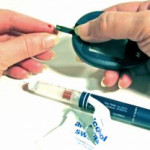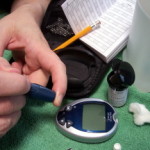Without insulin the sugar builds up in the bloodstream and eventually spills over into the kidneys. The buildup of sugar results in complications which include loss of eyesight, heart disease, stroke, kidney failure and nerve damage. Blood sugar will often be higher in individuals who have Type 1 diabetes then individuals who suffer from Type 2 diabetes.
The American Diabetes Association estimates that approximately 1.5 million people have Type 1 diabetes in the United States today. The exact cause of this condition is not known but many believe that it is the result of an infectious agent or a toxic insult to the immune system. It is not caused by obesity, diet or lack of exercise, which is what may trigger Type 2 diabetes.
More frequently the symptoms of Type-1 diabetes will occur suddenly and must be addressed as an emergency situation to prevent tragic results. Children will present with frequent urination, unexplained weight loss, extreme weakness or fatigue, numbness or tingling in the hands and feet, lethargy and drowsiness and a fruity odor to the breath.
 New treatment protocols developed in Alberta, Canada, involve transplantation of islet cells without the use of steroids to prevent rejection. This new technique has resulted in seven out of seven patients who have functioning islet cells without rejection or medications to prevent rejection for over one year! (5)
New treatment protocols developed in Alberta, Canada, involve transplantation of islet cells without the use of steroids to prevent rejection. This new technique has resulted in seven out of seven patients who have functioning islet cells without rejection or medications to prevent rejection for over one year! (5)
Diabetes insipidus is another form of diabetes that is not as well publicized and does not involve the metabolism of sugar. Instead it is a metabolic medical condition that involves a large excretion of urine because the kidneys lose their ability to concentrate the urine and returned fluid to the body. It is caused by a lack of anti-diuretic hormone that controls the ability of the kidney to concentrate urine. (6)
There are actually four different types of diabetes insipidus and all need to be treated differently. The most common cause is a lack of vasopressin, which is produced by the pituitary gland. The goal is to treat the diabetes insipidus to prevent dehydration and then find the reason for the destruction of the pituitary gland so that it can also be addressed.
About half of the time diabetes insipidus is caused by reasons that aren’t known or cannot be identified. The condition is permanent but there are medications which can easily control the symptoms. Individuals will continue to have several restrictions even though medication will help them stay under control. They must make good efforts to prevent dehydration and must always take their medication in order to be able to live a normal lifestyle.
References:
(1) University of Maryland Medical Center: Diabetes
http://www.umm.edu/altmed/articles/diabetes-000049.htm
(2) American Diabetes Associations: Diabetes Statistics
http://www.diabetes.org/diabetes-basics/diabetes-statistics/
(3) Diabetes Journal: Trends in Use of Oral Hypoglycemic Agents
http://care.diabetesjournals.org/content/11/7/558.full.pdf
(4) American Diabetes Association: Diabetes Basics
http://www.diabetes.org/diabetes-basics/type-1/
(5) University of Illinois At Chicago :Promising Advances in Islet Cell Transplants for Diabetics
http://www.sciencedaily.com/releases/2008/06/080609141225.htm
| Advertisement | |
 |
|

Leave a Reply